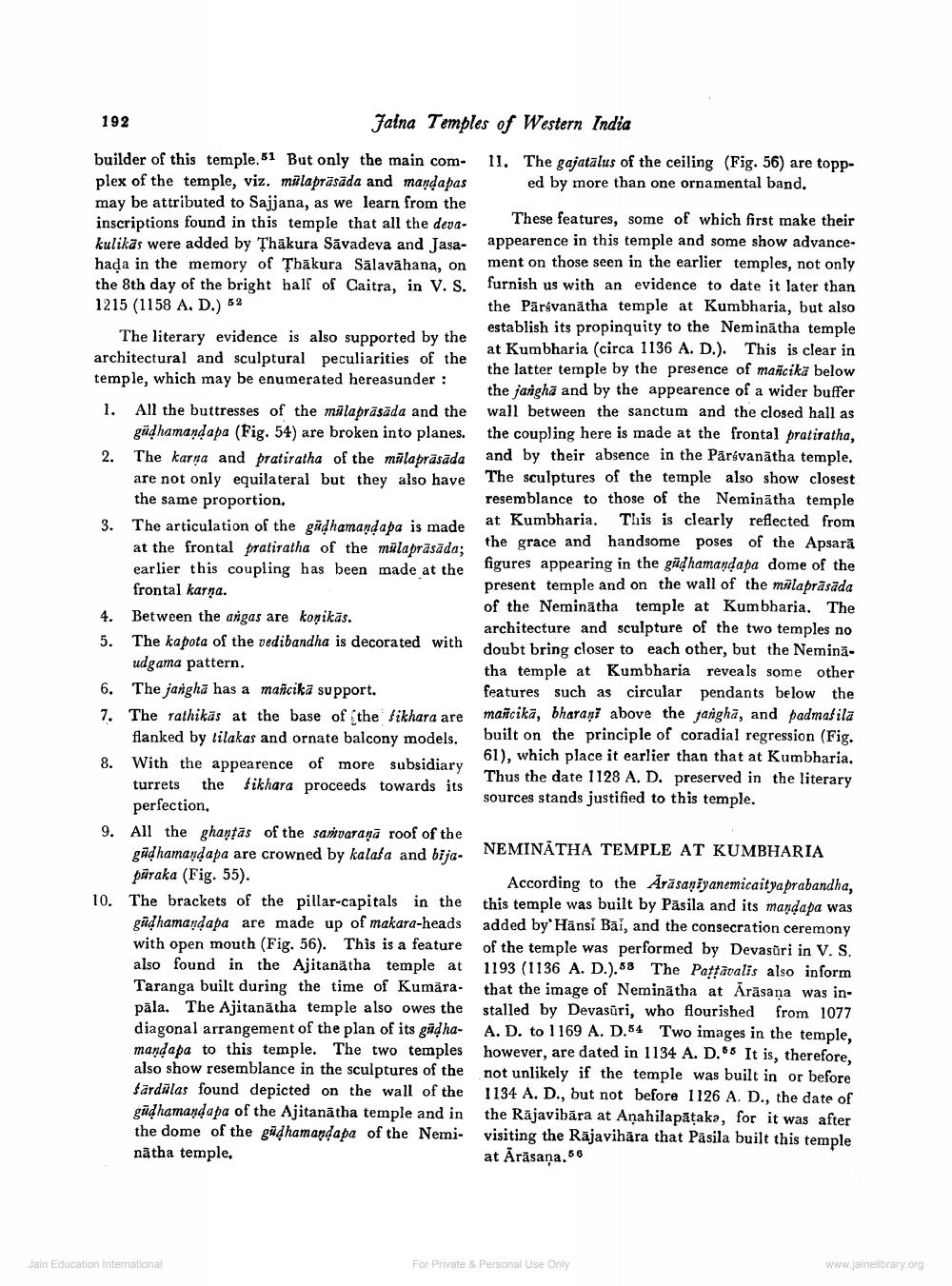________________
192
Jalna Temples of Western India
builder of this temple, 51 But only the main com- 11. The gajatalus of the ceiling (Fig. 56) are toppplex of the temple, viz. malaprāsāda and mandapas ed by more than one ornamental band. may be attributed to Sajjana, as we learn from the inscriptions found in this temple that all the deva
These features, some of which first make their kulikās were added by Thākura Sāvadeva and Jasa- appearence in this temple and some show advancehada in the memory of Thakura Salavāhana, on ment on those seen in the earlier temples, not only the 8th day of the bright half of Caitra, in V. S. furnish us with an evidence to date it later than 1215 (1158 A. D.) 52
the Pārsvanātha temple at Kumbharia, but also
establish its propinquity to the Neminātha temple The literary evidence is also supported by the
at Kumbharia (circa 1136 A. D.). This is clear in architectural and sculptural peculiarities of the
the latter temple by the presence of mañcika below temple, which may be enumerated hereasunder:
the jangha and by the appearence of a wider buffer 1. All the buttresses of the malapräsāda and the wall between the sanctum and the closed hall as
gūdhamandapa (Fig. 54) are broken into planes. the coupling here is made at the frontal pratiratha, The karna and pratiratha of the malaprāsāda and by their absence in the Pärsvanātha temple. are not only equilateral but they also have The sculptures of the temple also show closest the same proportion.
resemblance to those of the Neminātha temple 3. The articulation of the gūdhamandapa is made
at Kumbharia. This is clearly reflected from at the frontal pratiratha of the malaprāsāda;
the grace and handsome poses of the Apsarā earlier this coupling has been made at the
figures appearing in the gūdhamandapa dome of the frontal karņa.
present temple and on the wall of the malaprāsāda
of the Neminātha temple at Kumbharia. The 4. Between the angas are koņikās.
architecture and sculpture of the two temples no 5. The kapota of the vedibandha is decorated with
doubt bring closer to each other, but the Neminaudgama pattern.
tha temple at Kumbharia reveals some other 6. The janghā has a mañcikā support.
features such as circular pendants below the 7. The rathikās at the base of the Sikhara are mañcika, bharaṇi above the jangha, and padmašila flanked by tilakas and ornate balcony models. built on the principle of coradial regression (Fig.
61), which place it earlier than that at Kumbharia. With the appearence of more subsidiary
Thus the date 1128 A. D. preserved in the literary turrets the Sikhara proceeds towards its
sources stands justified to this temple. perfection, 9. All the ghanţās of the samvaraņā roof of the gūdhamandapa are crowned by kalata and bija- NE
NEMINĀTHA TEMPLE AT KUMBHARIA pāraka (Fig. 55).
According to the Ārāsaniyanemicaityaprabandha, 10. The brackets of the pillar-capitals in the this temple was built by Pasila and its mandapa was
gūdhamandapa are made up of makara-heads added by Hänsi Bai, and the consecration ceremony with open mouth (Fig. 56). This is a feature of the temple was performed by Devasūri in V. S. also found in the Ajitanätha temple at 1193 (1136 A. D.).53 The Pattavalis also inform Taranga built during the time of Kumāra. that the image of Neminātha at Ārāsana was inpāla. The Ajitanātha temple also owes the stalled by Devasūri, who flourished from 1077 diagonal arrangement of the plan of its gadha- A. D. to 1169 A. D.54 Two images in the temple. mandaba to this temple. The two temples however, are dated in 1134 A. D. It is, therefore, also show resemblance in the sculptures of the not unlikely if the temple was built in or before Sardalas found depicted on the wall of the 1134 A. D., but not before 1126 A. D., the date of gūdhamandapa of the Ajitanātha temple and in the Rajavibāra at Anahilapātaka, for it was after the dome of the gūdhamandapa of the Nemi- visiting the Rajavihāra that Päsila built this temple nātha temple.
at Ārāsaņa.66
Jain Education International
For Private & Personal Use Only
www.jainelibrary.org




